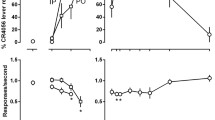Abstract
Rationale and objectives: The role of benzodiazepine (BZ) receptor mechanisms in modulating the stimulus effects of the BZ partial inverse agonist ethyl-β-carboline-3-carboxylate (β-CCE) are not well understood. The purpose of the present experiments was to assess the role of BZ and non-BZ receptor stimulation in the discriminative stimulus effects of β-CCE in rats. Methods: Adult male rats were trained to discriminate either a relatively high dose (10 mg/kg, n=8) or a relatively low dose (5.0 mg/kg, n=7) of β-CCE from saline under a fixed-ratio 10 schedule of food presentation. Results: Under the high-dose training condition, β-CCE engendered an increase in responding on the drug-paired lever up to 100% drug-lever responding, with no decrease in response rate. Diazepam, pentobarbital, flumazenil, (+)-amphetamine, and morphine did not share stimulus effects with 10 mg/kg β-CCE up to doses that suppressed rate of responding. The BZ full inverse agonist dimethoxy-4-ethyl-β-carboline-3-carboxylate also did not engender ≥80% β-CCE-lever responding up to doses that suppressed response rate and produced seizures in some animals. The BZ partial inverse agonists Ro 15-4513 and sarmazenil fully reproduced the stimulus effects of β-CCE. Flumazenil antagonized the effects of β-CCE with an in vivo apparent pA2 value of 6.1 (slope=–0.86). Under the low-dose condition, β-CCE engendered an increase in drug-lever responding, with no changes in response rate. In contrast to the high-dose condition, diazepam, pentobarbital, and (+)-amphetamine engendered high levels of β-CCE-lever responding (up to 77, 96, and 75%, respectively), whereas flumazenil and morphine did not engender full β-CCE- lever responding. Conclusions: These results indicated that the stimulus effects of the high dose of β-CCE appeared consistent with mediation by the drug’s partial inverse agonist effects at BZ receptors. The discriminative stimulus effects of β-CCE at the lower training dose, however, appeared to be relatively non-specific.
Similar content being viewed by others
Author information
Authors and Affiliations
Additional information
Received: 12 November 1998 / Final version: 15 March 1999
Rights and permissions
About this article
Cite this article
Rowlett, J., Wilcox, K. & Woolverton, W. Discriminative stimulus effects of ethyl-β-carboline-3-carboxylate at two training doses in rats. Psychopharmacology 145, 324–332 (1999). https://doi.org/10.1007/s002130051065
Issue Date:
DOI: https://doi.org/10.1007/s002130051065




